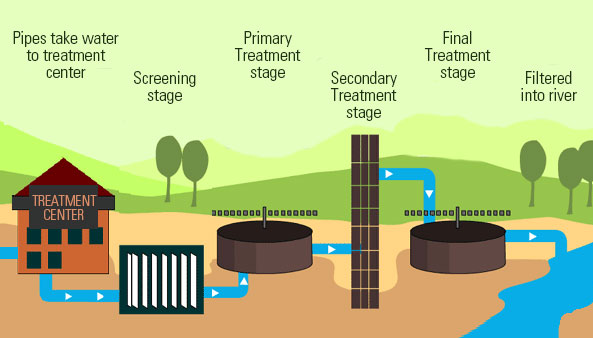- Water Pollution
Liquid Waste (Sewage/Wastewater) Treatment
Wastewater (liquid waste) from flushing the toilet, bathing, washing sinks, and general cleaning goes down the drain and into a pipe, which joins a larger sewer pipe under the road. The sewer pipe goes on to connect to a different sewer pipe that leads to the treatment center.

STAGE ONE: SCREENING
Screening is the first stage of the wastewater treatment process. Screening removes large objects like diapers, nappies, sanitary items, cotton buds, face wipes, and even broken bottles, bottle tops, plastics, and rags that may block or damage equipment.
Special equipment is used to remove grit that gets washed into the sewer.
STAGE TWO: PRIMARY TREATMENT
It involves the separation of solid, organic matter (or human waste) from the wastewater. It is done by putting the wastewater into large settlement tanks for the solids to sink to the bottom. The settled solids are called sludge. At the bottom of these circular tanks, large scrappers continuously scrape the floor of the tank and push the sludge toward the center, where it is pumped away for further treatment. The rest of the water is moved to Secondary treatment.
STAGE THREE: SECONDARY TREATMENT
The water, at this stage, is put into large rectangular tanks. These are called aeration lanes. Air is pumped into the water to encourage bacteria to break down the tiny bits of sludge that escaped the sludge scraping process.
STAGE FOUR: FINAL TREATMENT
Next, the ‘almost’ treated wastewater is passed through a settlement tank. Here, more sludge is formed at the bottom of the tank from the settling of the bacterial action. Again, the sludge is scraped and collected for treatment. The water at this stage is almost free from harmful substances and chemicals. The water is allowed to flow over a wall where it is filtered through a bed of sand to remove additional particles.
After that, the filtered water is discharged into the river.
*This description is not a standard for all treatment plants, but the principle is similar.
Now let us see some stunning facts and disasters from water pollution in recent times.
